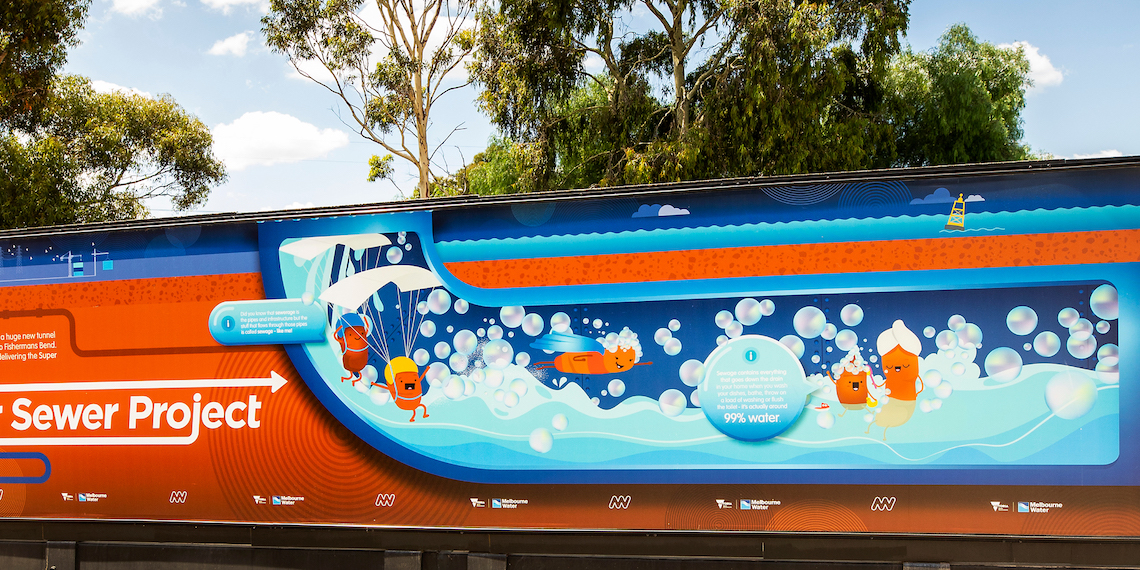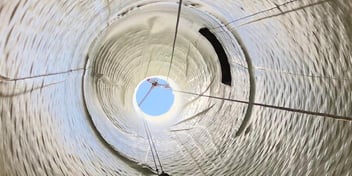Aussie utility wins international prize for sewer upgrade campaign

A public communication program for a Melbourne Water sewer upgrade has been recognised internationally, with the utility’s creative outreach efforts being awarded Gold at the 2023 Better Future GOV Design Awards in New York.
Designed to educate the public about its Hobson Bay Main Sewer upgrade, the Melbourne Water campaign, which involved a vividly designed hoarding – the temporary fence surrounding a construction site – and an associated online game, was recognised in the Marketing – Print category of the awards, which “celebrate the courage of commissioners and creators of design projects within the government, community, and public sectors”.
The winning hoarding design was erected at the Scienceworks technology museum in Melbourne’s inner west.
“We were able to breathe life and energy into sewer project facts and figures creating an engaging platform that discusses and promotes how the project supports plans for the future of Melbourne’s increasing population,” said Andrew Mellor, Melbourne Water’s Manager of Operational Communications and Engagement.
“Instead of just having hoarding to protect visitors to Scienceworks, we took this as an opportunity to connect and educate curious minds on how the new sewer pipeline will transfer 30% of Melbourne’s wastewater to the Western Treatment Plant to support Melbourne’s growing population, as well as highlight the pipeline’s history and the technology behind the project through a playful and fun journey of discovery.”
Graphic display
The Melbourne Water campaign, developed with Scienceworks, John Holland and designers GrowCreative, used the hoarding to show “cute Poo-like characters delivering project centric messaging through a playful and fun journey of discovery”, Mellor said.
Designed to appeal to children and families, the hoarding incorporated nine viewing windows, allowing curious onlookers a view of the construction site, and featured QR codes that took visitors to an online game named “Drip Trip”. In all, 200 metres of banners are used in the display.
“GrowCreative softened the awkward and uncomfortable conversation of sewage and made it fun and playful. A connected super sewer pipeline graphic travelled uninterrupted through the first 147.5 metres of hoarding delivering project messaging,” Mellor said.
“The construction hoarding was an opportunity to add value to the Scienceworks experience by developing a suite of graphics that demonstrated the community benefit of the project works being undertaken, enhancing the water literacy of visitors, giving an insight into the technology of the sewer and the construction taking place, and shining a light on the history of the existing pipeline and the heritage of the pumping station living in the Scienceworks site.”
The site’s hoarding was divided into different themes that took viewers through all aspects of the water cycle, adding information about the project construction and the tunnel boring machines being used, as well as providing historical context.
“Through community engagement and education programs such as this one, we combine immersive storytelling to connect community with our work and to value water and the environment,” Mellor said.
“Each day, we see families engaging with the content and peering excitedly through the viewing window, shifting the works from an inconvenience to an exciting look into a real-life engineering project.”
Time to refresh
First constructed in the 1960s, the Hobsons Bay Main Sewer transfers about 30% of the city’s wastewater to its Western Treatment Plant. The upgrade is being rolled out to extend the life of this important part of Melbourne’s sewer network.
“In 2021-22, Melbourne Water invested $251 million to safely manage the sewage generated by a growing city,” Mellor said.
“This included starting construction on a major $200 million project that will duplicate the Hobsons Bay Main Sewer under the Yarra River to connect into the existing sewer located at Scienceworks, due for completion in 2029.”
And by 2030, Melbourne’s population will have grown to more than six million, all needing water services.
“In the decade that matters, it’s essential that we educate the community about all aspects of the water cycle,” Mellor said.
“[The] community tells us that it is important to understand the interconnectedness of the system, and it provides the knowledge required when there are opportunities to directly input into how we shape future development of our services.”
Mellor said the success of the campaign will “absolutely” inspire future campaigns from the utility, and he urges anyone in the city to head to Scienceworks to see the award-winning platform in person.
“Melbourne Water will continue to look for new and innovative ways to combine immersive storytelling and technology to connect the community with our work,” he said.


